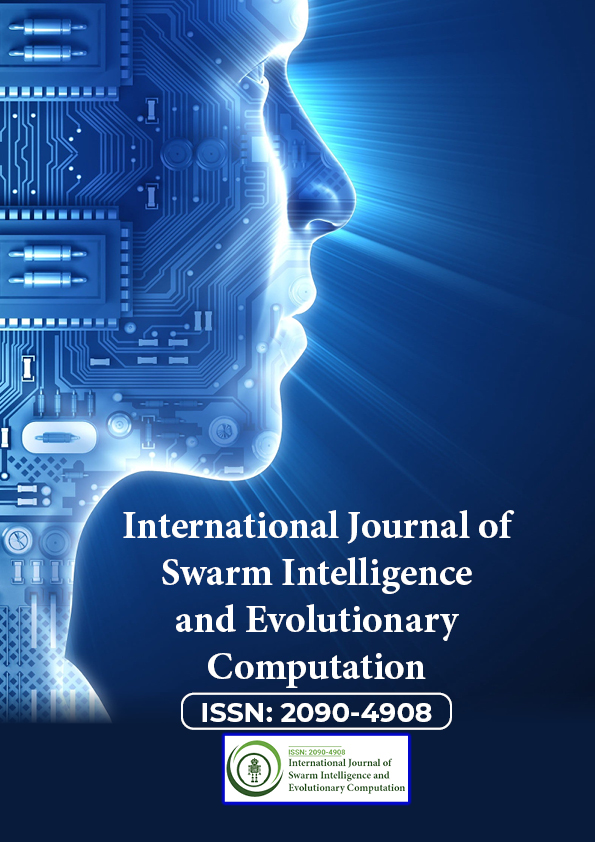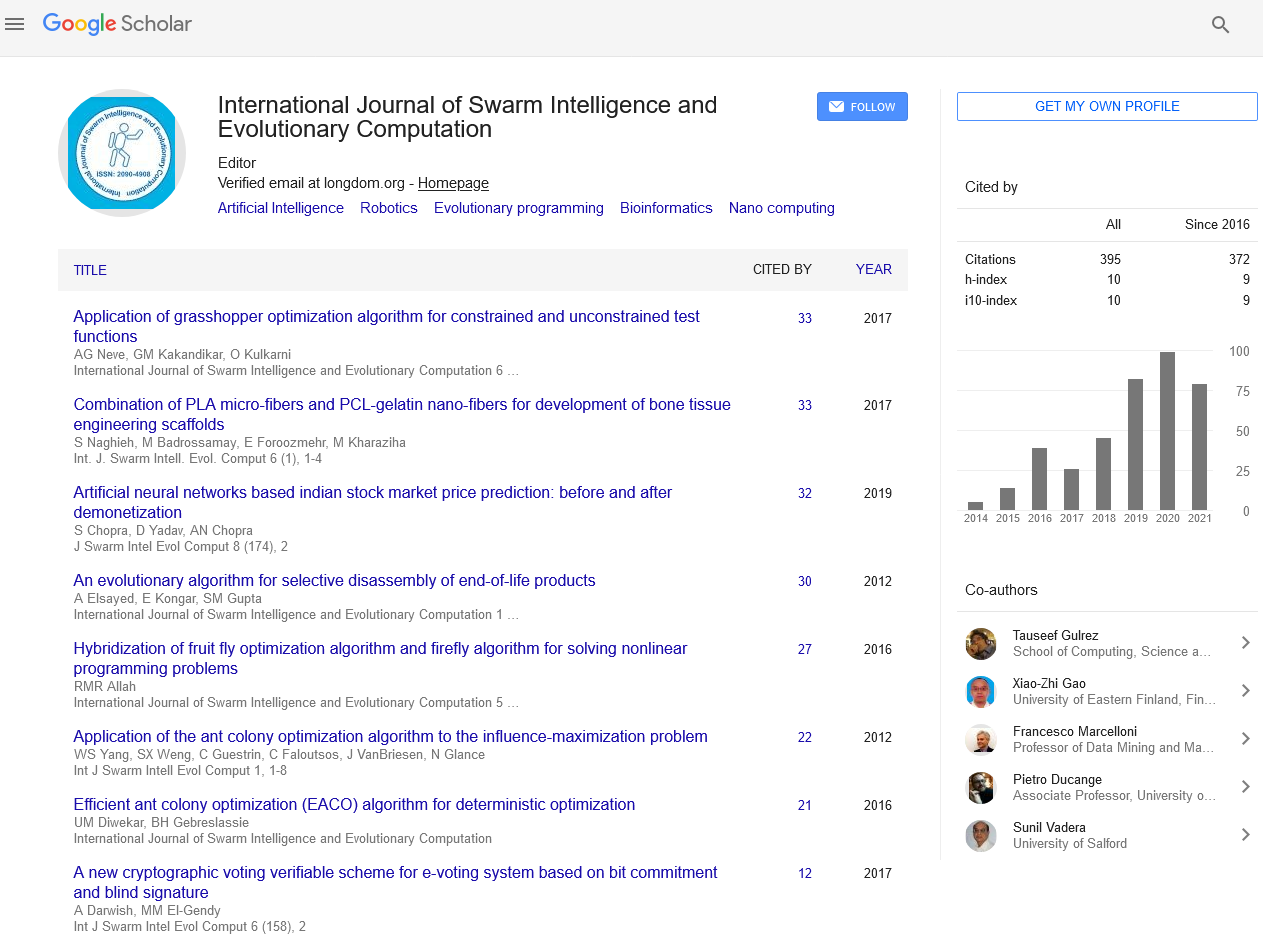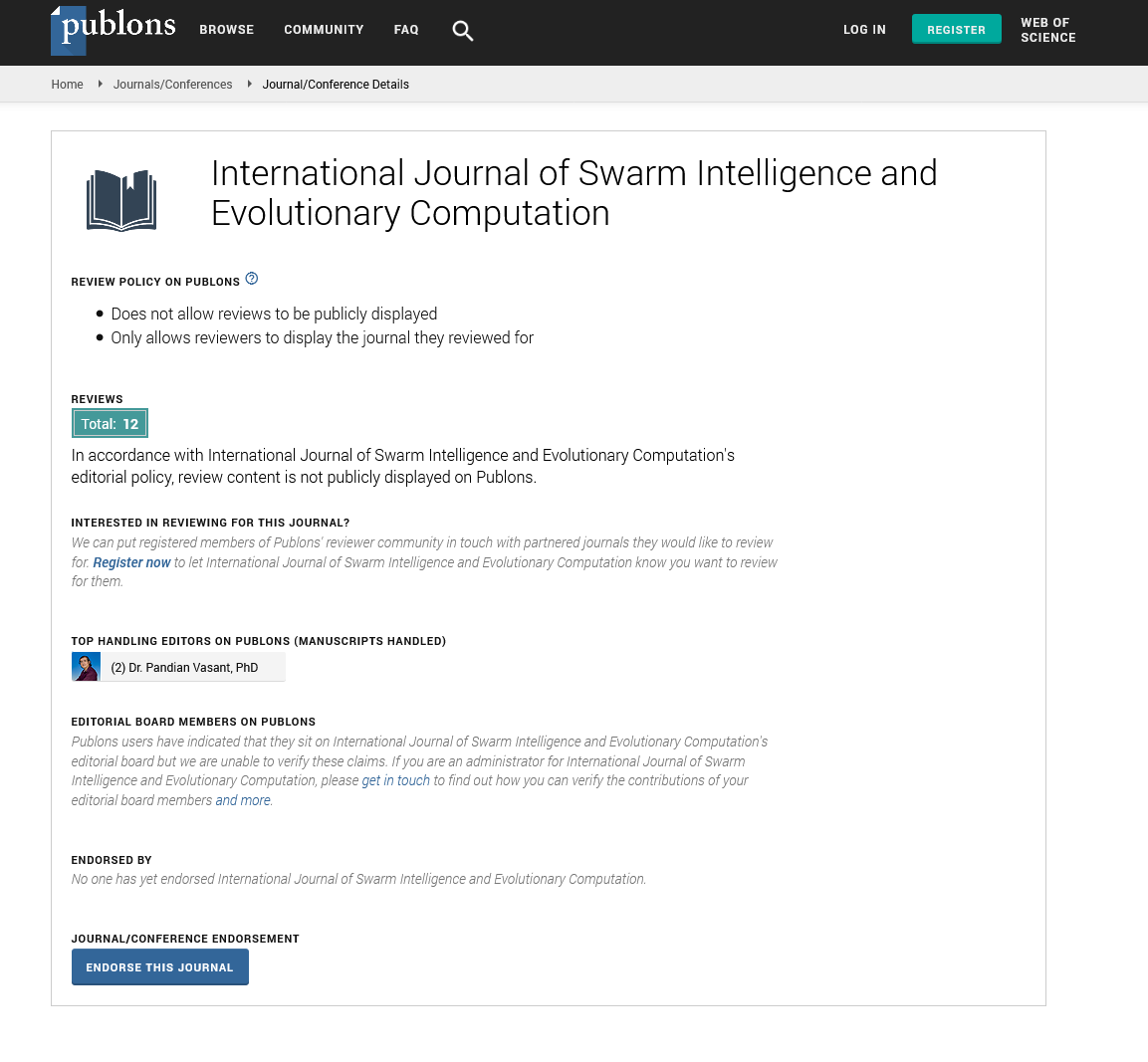Indexed In
- Genamics JournalSeek
- RefSeek
- Hamdard University
- EBSCO A-Z
- OCLC- WorldCat
- Publons
- Euro Pub
- Google Scholar
Useful Links
Share This Page
Journal Flyer

Open Access Journals
- Agri and Aquaculture
- Biochemistry
- Bioinformatics & Systems Biology
- Business & Management
- Chemistry
- Clinical Sciences
- Engineering
- Food & Nutrition
- General Science
- Genetics & Molecular Biology
- Immunology & Microbiology
- Medical Sciences
- Neuroscience & Psychology
- Nursing & Health Care
- Pharmaceutical Sciences
Commentry - (2024) Volume 13, Issue 2
Exploring Optimization Frontiers: The Impact of Artificial Bee Swarm Algorithm
Evelyn Sams*Received: 01-Mar-2024, Manuscript No. SIEC-24-25333; Editor assigned: 04-Mar-2024, Pre QC No. SIEC-24-25333 (PQ); Reviewed: 18-Mar-2024, QC No. SIEC-24-25333; Revised: 26-Mar-2024, Manuscript No. SIEC-24-25333 (R); Published: 04-Apr-2024, DOI: 10.35248/2090-4908.24.13.358
Description
Artificial Bee Swarm Algorithm (ABSA) is a population-based metaheuristic optimization algorithm inspired by the foraging behavior of honeybees. Introduced by Dervis Karaboga in 2005, ABSA has gained significant attention due to its simplicity, efficiency, and effectiveness in solving complex optimization problems. Drawing inspiration from the collective intelligence exhibited by natural bee colonies, ABSA employs the principles of swarm intelligence to iteratively search for optimal solutions. It aims to elucidate the working principles, algorithmic components, and applications of ABSA, providing insights into its efficacy and potential for addressing diverse optimization challenges.
Working principles of ABSA
At the heart of ABSA lies the emulation of the foraging behavior of honeybees, which involves three primary components: employed bees, onlooker bees, and scout bees. Employed bees exploit the food sources (solution space) by performing local search around the neighborhood of their current solutions. Onlooker bees select food sources based on their quality and perform exploitation by following employed bees' guidance. Scout bees explore new food sources by randomly searching the solution space to rejuvenate the population and prevent premature convergence. Through the collaborative efforts of these bee types, ABSA iteratively refines the solutions towards optimal or near-optimal solutions.
Algorithmic components of ABSA
Algorithmic components include:
Initialization: ABSA initializes a population of candidate solutions, often randomly distributed across the solution space.
Employed bee phase: Employed bees iteratively improve the solutions by exploring the neighborhood of their current solutions and updating them based on the quality of the discovered solutions.
Onlooker bee phase: Onlooker bees select promising solutions based on their quality and perform exploitation to refine them further.
Scout bee phase: Scout bees perform exploration by randomly searching the solution space to discover new solutions and diversify the population.
Termination criteria: ABSA terminates when a predefined stopping criterion is met, such as reaching a maximum number of iterations or achieving a satisfactory solution quality.
Applications of ABSA
ABSA has demonstrated its efficacy across various domains, including but not limited to:
Engineering: Optimization of engineering designs, parameter tuning in machine learning algorithms, and scheduling problems in manufacturing processes.
Logistics and transportation: Vehicle routing optimization, facility location, and scheduling in transportation networks.
Finance: Portfolio optimization, risk management, and prediction models in financial markets.
Telecommunications: Optimization of network routing, resource allocation in wireless networks, and spectrum management.
Performance analysis and comparison
ABSA's performance is influenced by various factors such as population size, neighborhood size, and exploration-exploitation balance. Comparative studies have shown that ABSA often outperforms traditional optimization algorithms such as genetic algorithms and particle swarm optimization in terms of solution quality, convergence speed, and robustness to parameter settings.
However, its performance may vary depending on the problem characteristics and parameter settings.
Future directions and challenges
Despite its effectiveness, ABSA still faces several challenges, including the need for better exploration-exploitation balance, scalability to high-dimensional problems, and adaptability to dynamic environments. Future research directions may focus on enhancing ABSA's robustness, scalability, and versatility through hybridization with other optimization techniques, incorporation of adaptive mechanisms, and development of parallel and distributed variants.
Conclusion
In conclusion, Artificial Bee Swarm Algorithm (ABSA) offers a promising approach to solving complex optimization problems by leveraging the collective intelligence of artificial bee colonies. Through its emulation of the foraging behavior of honeybees, ABSA effectively explores the solution space, exploits promising solutions, and maintains population diversity. As research in swarm intelligence and optimization continues to evolve, ABSA holds immense potential for addressing diverse optimization challenges across various domains.
Citation: Sams E (2024) Exploring Optimization Frontiers: The Impact of Artificial Bee Swarm Algorithm. Int J Swarm Evol Comput. 13:358.
Copyright: © 2024 Sams E. This is an open-access article distributed under the terms of the Creative Commons Attribution License, which permits unrestricted use, distribution, and reproduction in any medium, provided the original author and source are credited.


